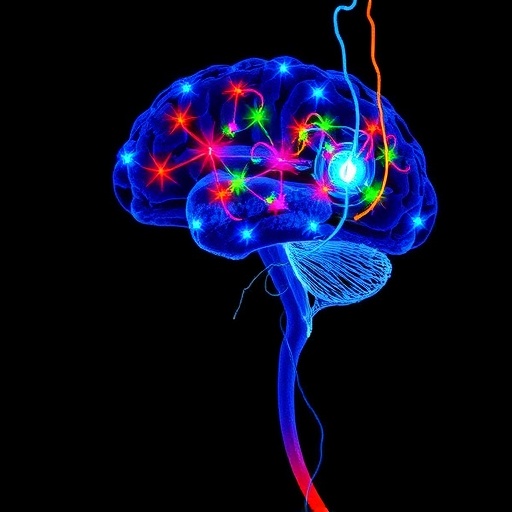In a groundbreaking study poised to reshape our understanding of fear responses, researchers led by Chien et al. have made significant strides in elucidating the mechanisms underlying anxiety and innate fear in mice. Their work reveals a critical relationship between acid-sensing ion channels (ASICs) and the behaviors associated with anxiety and fear. This investigation, focusing on the amygdala and bed nucleus of the stria terminalis (BNST), offers fresh insights that could one day lead to innovative treatments for anxiety disorders in humans.
Central to their investigation was the role of ASIC1a, an ion channel that has attracted attention for its involvement in neuronal signaling and behavioral responses. The study highlights how the absence of ASIC1a in ASIC4-positive neurons has profound effects on emotional behaviors, notably reducing anxiety and innate fear responses. This was discovered through a series of meticulously designed experiments that underscore the interplay between genetic expression and behavioral outcomes.
The amygdala, a well-known hub for processing emotions such as fear and aggression, works in close conjunction with the BNST, a region implicated in the modulation of anxiety-related behaviors. The authors undertook extensive assessments of how deleting ASIC1a specifically in ASIC4-expressing neurons alters the activity and connectivity of these critical brain regions. Their results indicate a complex signaling pathway that merits further exploration.
Utilizing a variety of behavioral tests, including the elevated plus maze and open field tests, the researchers quantitatively measured the anxiety levels of the mice lacking ASIC1a. Remarkably, these mice exhibited a marked decrease in anxiety-like behavior, suggesting that ASIC1a plays a pivotal role in the neural circuits governing emotional responses. This finding is not only compelling in itself but also raises intriguing questions about the potential of targeting ASICs in treating anxiety disorders.
Moreover, the implications of such a discovery extend beyond basic science. Given the rising incidence of anxiety disorders globally, the possibility of harnessing ASIC modulators as therapeutic agents is tantalizing. Traditionally, treatments for anxiety have relied on pharmacological interventions that can produce variable efficacy and unwanted side effects. In contrast, targeting specific ion channels like ASIC1a may provide a more tailored and effective approach.
The innovative methodologies employed in this research have further enriched the field of neuroscience. The combination of genetic engineering techniques to create knockout mice, alongside refined behavioral assays, constitutes a powerful toolkit for dissecting the neural circuits involved in complex emotional behaviors. As the research community increasingly embraces such interdisciplinary approaches, it opens the door to a new era of discoveries pertaining to the neural underpinnings of mental health.
Interestingly, the findings also resonate with broader neurobiological principles. The intricate relationship between ion channels and neural circuit dynamics underscores how subtle changes on a molecular level can manifest in significant behavioral outcomes. This is a critical reminder of the importance of understanding the cellular mechanisms that underlie behavior, potentially paving the way for more effective interventions in mood and anxiety disorders.
In addition to the implications for treatment, the research provides a platform for future investigations into the molecular biology of emotion regulation. As scientists continue to explore the roles of various ASIC subtypes, there is a growing acknowledgment of the potential for precision neuromodulation. This is particularly crucial as our understanding of brain chemistry evolves, revealing the complex interplay between different ion channels, neurotransmitters, and neuropeptides.
Furthermore, the reduction of innate fear responses in ASIC1a-deficient mice opens up intriguing avenues for examining how fear learning and memory might be altered. Investigating this aspect could yield insights into other conditions, such as post-traumatic stress disorder (PTSD), where the modulation of fear responses is a key therapeutic target. Collaboratively, this study encourages an integrative approach to mental health research, drawing from genetics, behavioral neuroscience, and pharmacology to formulate comprehensive strategies for intervention.
As we anticipate future research stemming from this study, one can only speculate on the broader applications of ASIC modulation. With a rising focus on personalized medicine in mental health, the identification of individuals who may benefit from ASIC-targeting therapies could help mitigate the burden of anxiety disorders. This could mark a substantial shift in how treatment plans are conceived and implemented in clinical settings.
Ultimately, the work by Chien et al. represents more than just an academic achievement; it embodies the potential to intervene fundamentally in the sphere of emotional well-being. As science journalism continues to spotlight such revelations, we are reminded of the proactive role that researchers play in shaping the future of medical science, translating curiosity into critical understandings that could alleviate human suffering.
The authors’ findings emphasize the critical importance of further research into ASIC channels and related mechanisms. Identifying the networks and pathways influenced by ASIC1a will undoubtedly provoke new hypotheses and therapeutic avenues for investigation. As anxiety disorders persist as a leading public health concern, understanding the biological underpinnings remains imperative in our collective journey toward mental health advancement.
In conclusion, the discovery that lacking ASIC1a in ASIC4-positive neurons significantly reduces anxiety and innate fear in mice opens up a plethora of research opportunities. It invites the scientific community to delve deeper into the complexities of emotional regulation and neurological health. The implications of this study could reverberate beyond the laboratory, offering hope for millions grappling with anxiety disorders.
Subject of Research: The relationship between ASIC1a and anxiety/fear responses in the amygdala and BNST of mice.
Article Title: Lacking ASIC1a in ASIC4-positive amygdala/bed nucleus of the stria terminalis (BNST) neurons reduces anxiety and innate fear in mice.
Article References:
Chien, YC., Lin, SH., Lien, CC. et al. Lacking ASIC1a in ASIC4-positive amygdala/bed nucleus of the stria terminalis (BNST) neurons reduces anxiety and innate fear in mice.
J Biomed Sci 32, 43 (2025). https://doi.org/10.1186/s12929-025-01138-6
Image Credits: AI Generated
DOI: 10.1186/s12929-025-01138-6
Keywords: ASIC1a, anxiety, innate fear, amygdala, bed nucleus of the stria terminalis, neuronal signaling, ion channels, anxiety disorders, emotional regulation.




